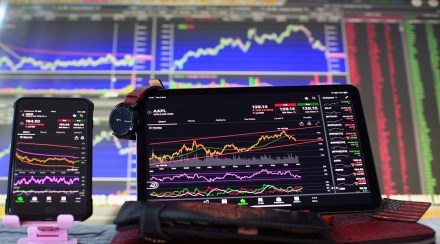Indian equity markets are likely to open lower on Wednesday, hinted SGX Nifty. Nifty futures traded 298 points, or 1.65% lower at 17,794 on the Singapore Exchange, signaling that BSE Sensex, NSE Nifty 50 were headed for a gap-down start. “The current market buoyancy globally, including in India, is based on the expectation that inflation has peaked along with softening crude prices. We believe that, to an extent, the expectation of inflation peaking is right, but one will have to keep an eye on energy prices in Europe & US with the onset of winter, which can re-ignite the inflation fire. The current momentum in the equity markets can sustain, but we would advise investors to raise some cash at the current levels, which can be deployed if the markets correct on either rate hikes or energy prices moving up again,” said Naveen Kulkarni, Chief Investment Officer, Axis Securities PMS.
Also Read: JSW Steel, Infosys, Vedanta, Jet Airways, Future Lifestyle, Bharat Forge, KEC International stocks in focus
Five things to know before share market opening bell
Global market watch: All three major US stock indices veered sharply lower on Tuesday, snapping four-day winning streaks and notching their biggest one-day percentage drops since June 2020 in throes of the Covid-19 pandemic. The Dow Jones Industrial Average fell 3.94%, the S&P 500 lost 4.32%, and the Nasdaq Composite dropped 5.16%. Asian shares tumbled today morning, the dollar held firm and the US yield curve was deeply inverted, as a white-hot US inflation report dashed hopes for a peak in inflation and fuelled bets that interest rates may have to be raised higher and for longer. MSCI’s broadest index of Asia-Pacific shares outside Japan fell 1.3% in early Asia trade, while Japan’s Nikkei 225 tumbled 2.7%.
Nifty technical view: “A small positive candle was formed on the daily chart with minor upper and lower shadow and with opening upside gap. Technically, this market action signal a formation of spinning top type of candle pattern at the highs. Normally, a spinning top formation after a reasonable upmove or at the hurdle could be considered as a reversal pattern post confirmation. Hence, any weakness from here or from highs could confirm top reversal pattern. However, a sustainable move above this patterns high at 18088 levels is likely to negate the bearish implication. The short term trend of Nifty continues to be positive amidst a range movement,” said Nagaraj Shetti, Technical Research Analyst, HDFC Securities.
Levels to watch for: The Nifty is trading with higher high & higher low formations from the last 5 trading sessions on daily charts suggesting strength in the counter. “The support for Nifty has shifted around 17900 levels while on the upside, 18180 may act as an immediate hurdle. On the other hand, Bank Nifty has support at 40000 levels while resistance at 41400 levels. Overall, till the time nifty holds the 18000 level, it’s looking strong on charts crossing above 18180 marks will open the gate for 18400-18500 levels. FMCG stocks look positive on charts; one can accumulate on dips,” said Palak Kothari, Senior Technical Analyst, Choice Broking
IPO watch: Harsha Engineers International garnered Rs 225.7 crore from anchor investors ahead of its IPO that opens for public subscription today, The company informed the bourses that it allocated 68,40,855 shares at Rs. 330 per share on Tuesday to anchor investors. American Funds Insurance Series Global Small Capitalization Fund, Goldman Sachs Funds – Goldman Sachs India Equity Portfolio, PineBridge Global Funds – PineBridge India Equity Fund, Abu Dhabi Investment Authority-Monsoon are among the investors that participated in the anchor book.
Also Read: Sensex, Nifty end at 5-month high, Nifty support at 18000, what do charts say? Investors eye US inflation data
Stocks under F&O ban on NSE: Indiabulls Housing Finance, Ambuja Cements, and Delta Corp remain the three stocks under the NSE F&O ban list for September 14. Securities thus banned under the F&O segment include companies where derivative contracts have crossed 95 percent of the market-wide position limit.
